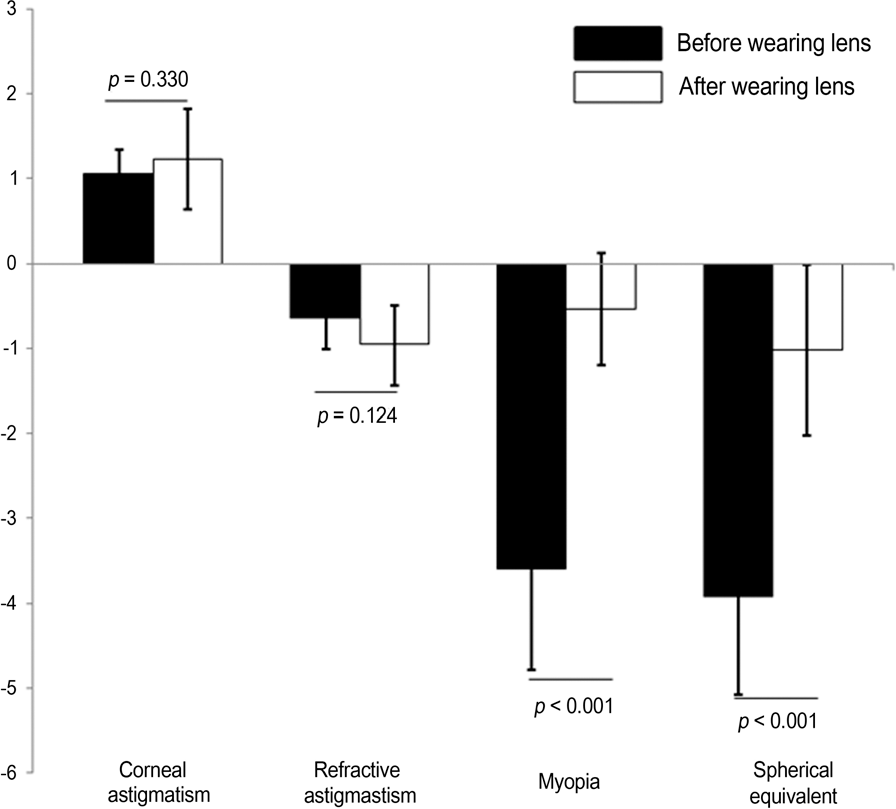Abstract
Purpose:
To report the efficacy of toric orthokeratology lenses in patients with astigmatism within 1.5 D having difficulty in wear-ing spherical orthokeratology lenses due to the limbus-to-limbus corneal astigmatism.
Methods:
Twenty-three eyes of 16 patients with limbus-to-limbus corneal astigmatism who had been wearing toric orthokeratol-ogy lenses for more than 6 months were recruited. The uncorrected visual acuity (UCVA), refractive error, and keratometric changes including eccentricity before and after wearing lenses were compared, and the correlations between corneal astigma-tism as well as refractive astigmatism and lens toricity were assessed.
Results:
After wearing the lens, UCVA (log MAR) significantly improved from 0.61 ± 0.22 to 0.05 ± 0.08 ( p < 0.001). Myopia and spherical equivalent were also reduced significantly ( p < 0.001 and p < 0.001, respectively). While Simulated K (Sim K) tended to be more flattened ( p < 0.001) and the eccentricity showed significant decrease ( p < 0.001), corneal and refractive astigmatism were not changed significantly ( p = 0.330 and p = 0.124, respectively). Correlations between corneal and refractive astigmatism and lens toricity were not statistically significant (r = 0.244, p = 0.300; r = -0.051, p = 0.832). No patients showed lens decentra-tion or visual discomfort.
References
1. Grosvenor T, Perrigin DM, Perrigin J, Maslovitz B. Houston Myopia Control Study: a randomized clinical trial. Part II Final re-port by the patient care team. Am J Optom Physiol Opt. 1987; 64:482–98.
2. Chung K, Mohidin N, O’Leary DJ. Undercorrection of myopia en-hances rather than inhibits myopia progression. Vision Res. 2002; 42:2555–9.

3. Grosvenor T, Perrigin J, Perrigin D, Quintero S. Use of siliconea-crylate contact lenses for the control of myopia: results after two years of lens wear. Optom Vis Sci. 1989; 66:41–7.

4. Chua WH, Balakrishnan V, Chan YH. . Atropine for the treat-ment of childhood myopia. Ophthalmology. 2006; 113:2285–91.

5. Cho P, Cheung SW. Retardation of Myopia in Orthokeratology (ROMIO) Study: a 2-year randomized clinical trial. Invest Ophthalmol Vis Sci. 2012; 53:7077–85.

6. Cheung SW, Cho P. Subjective and objective assessments of the ef-fect of orthokeratology-a cross-sectional study. Curr Eye Res. 2004; 28:121–7.
7. Chan B, Cho P, Cheung SW. Orthokeratology practice in children in a university clinic in Hong Kong. Clin Exp Optom. 2008; 91:453–60.

8. Cheung SW, Cho P, Chan B. Astigmatic changes in orthokera-tology. Optom Vis Sci. 2009; 86:1352–8.

9. Park YK, Lee JS, Lee JE. Correction of limbus-to-limbus corneal astigmatism with toric orthokeratology lenses. J Korean Ophthalmol Soc. 2013; 54:502–7.

10. Pauné J, Cardona G, Quevedo L. Toric double tear reservoir con-tact lens in orthokeratology for astigmatism. Eye Contact Lens. 2012; 38:245–51.

11. Choi JH, Ryu JW, Lee YC, Kim HS. An analysis of correlation with visual acuity, refractive error and corneal astigmatism after wearing of reverse geometry lenses. J Korean Ophthalmol Soc. 2006; 47:1266–73.
12. Kawamorita T, Uozato H, Kamiya K. . Repeatability, reprodu-cibility, and agreement characteristics of rotating Scheimpflug photography and scanning-slit corneal topography for corneal power measurement. J Cataract Refract Surg. 2009; 35:127–33.

13. Jain R, Dilraj G, Grewal SP. Repeatability of corneal parameters with Pentacam after laser in situ keratomileusis. Indian J Ophthalmol. 2007; 55:341–7.
14. Kleinstein RN, Jones LA, Hullett S. . Refractive error and eth-nicity in children. Arch Ophthalmol. 2003; 121:1141–7.

15. Bourne RR, Dineen BP, Ali SM. . Prevalence of refractive error in Bangladeshi adults: results of the National Blindness and Low Vision Survey of Bangladesh. Ophthalmology. 2004; 111:1150–60.
16. Cho P, Cheung SW, Edwards M. The longitudinal orthokeratology research in children (LORIC) in Hong Kong: a pilot study on re-fractive changes and myopic control. Curr Eye Res. 2005; 30:71–80.

17. Mountford J.An analysis of the changes in corneal shape and re-fractive error induced by accelerated orthokeratology. Int Contact Lens Clin. 1997; 24:128–44.

18. Soni PS, Horner DG. Clinical contact lens practice. 1st. Philadelphia: JB Lippincott;1993. p. 1–7.
19. Joe JJ, Marsden HJ, Edrington TB. The relationship between cor-neal eccentricity and improvement in visual acuity with orthokeratoloy. J Am Optom Assoc. 1996; 67:87–97.
20. Yun YM, Kim MK, Lee JL. Change of corneal parameters after re-moving reverse geometry lens in moderate degree myopia. J Korean Ophthalmol Soc. 2005; 46:1478–85.
21. Chen C, Cho P. Toric orthokeratology for high myopic and astig-matic subjects for myopic control. Clin Exp Optom. 2012; 95:103–8.

22. Chen CC, Cheung SW, Cho P. Toric orthokeratology for highly as-tigmatic children. Optom Vis Sci. 2012; 89:849–55.

23. Sanders DR, Koch DD. An atlas of corneal topography. 1st. New Jersey: Slack Incorporated;1993. p. 5563.
Figure 2.
Comparison of refractive changes between before and after wearing toric orthokeratology lens. Corneal and re-fractive astigmatism did not change significantly after wearing lens.

Table 1.
Dermographics of patients
| Patients | |
|---|---|
| Eyes (n) | 23 |
| OD/OS (eyes) | 12/11 |
| Male/female (n) | 5/11 |
| Age (years, range) | 14 (7-40) |
| Follow up period (months, range) | 12 (6-23) |
Table 2.
Comparison of uncorrected visual acuity, refractive error, and keratometric value




 PDF
PDF ePub
ePub Citation
Citation Print
Print





 XML Download
XML Download